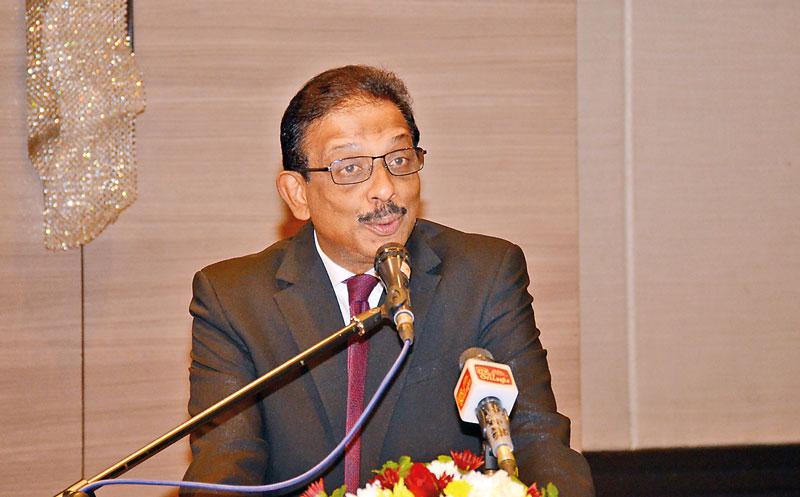Reply To:
Name - Reply Comment

Treasury Secretary Sajith Attygalle
Pic by Waruna Wanniarachchi
By Nishel Fernando
Amid a fiscal deficit forecast of 7.5 percent of GDP this year, the government expects the State revenue to pick up from the second half of this year, driven by the anticipated uptick in consumption and investment activities from the announced tax cuts.
“When the government settles the previous government’s unsettled payments running into Rs.200 billion, the budget deficit which was to be 5 percent, will now be increased to almost 7.5 percent. This means some of the expenditures planned for 2020 will have to be trimmed to contain the fiscal impact,” Treasury Secretary Sajith Attygalle said.
He was delivering the keynote address at the Annual General Meeting of Sri Lanka Apparel Exporters Association in Colombo this week.
According to him, Sri Lanka’s economic growth is estimated to have slowed down to 2.7 percent in 2019 with a debt stock of around 82 percent of GDP.
In 2019, the State revenue declined below the 2018 figure to Rs 1.8 trillion, which is also below the target of Rs 2.4 trillion.
The Treasury is projecting the State revenue to remain around 11.5 percent of GDP this year.
Despite an initial decline in State revenue, Attygalle defended the sweeping tax cuts noting that a simple tax structure with low rates is the best possible way to revive economic activities.
“There are many ways of reviving the economy, but no economy was able to revive with high taxation in times of trouble.
In fact high tax rates get economies into trouble. While there could be an initial decrease in government income, it will pick up especially from second half of the year,” he stressed.
The government expects the announced tax cuts in particular, would revitalise the small and medium-sized enterprise (SME) sector and the rural economy which had suffered serious setbacks during last few years.
Further, Attygalle noted that favourable weather conditions and bumper harvest in Maha season will further facilitate better money circulation in rural areas.
With the anticipated growth in economic activities in the SME sector, he pointed out that banking sector assets quality would also improve as SMEs account for 25 percent of non-performing loans (NPLs) in the banking sector.
“That’s why we are confident that once disposable income increases, investments will increase and banks will also see a quality enhancement in their loan portfolio,” he said.
Meanwhile, Attygalle stressed that the government is committed to expenditure rationalisation in the State sector to contain the fiscal deficit within limits.
“I have issued a circular to all spending agencies stating that they must identify expenditure rationalising measures and they will be monitored by the Department of Management Audit of the Treasury,” he added.
Further, he noted that the Treasury will keep a close watch on the performance of SOEs while stressing that the newly appointed SOE director boards have been advised to “clean up their act and deliver.”
“SOE boards have to deliver. We will introduce performance review mechanisms to these boards with the support of the government,” he added.
The Treasury aims to contain the budget deficit to 4.5 percent from 2021 onwards and to maintain the foreign exchange rate at Rs.180-182 per US dollar and create a stable environment for businesses with added transparency in financing.
“From 2021 onwards, the fiscal deficit will be maintained around 4.5 percent. That means government borrowings are not expected to spruce up interest rates upwards. We expect a fairly low interest rate regime.
“We wish to explain our borrowings with far more due diligence, better project planning and concerns for variables such as maturity, currency mismatch and etc,” he elaborated.
Attygalle also promised to deliver the long-delayed structural reforms to maintain economic growth momentum. “We are mindful that cyber space will dominate the way we do business. E-commerce creates opportunities and we will address the requirement to have a platform that will facilitate the e-market place where Sri Lankan brands and companies will have more opportunities,” he said. Outlining Sri Lanka’s trade policy, he revealed government’s plans to engage with the country’s trading partners to explore how best future free trade agreements (FTAs) can be structured while strengthening the country’s anti-dumping drive.
“Our trade policy will be driven by a system of free trade. But we will protect local businesses against unfair competition. We will strengthen our anti-dumping mechanism. In this regard, our institutions from Customs to Quarantine need to be upgraded,” he said.
Attygalle also stressed that the government will maintain a stable and consistent tax policy while supporting industries.
“The government is focused on providing infrastructure and logistics support and we will make our industries competitive. Our tax policy is to ensure a simple tax system with low rates. This will not face significant changes annually,” he said.